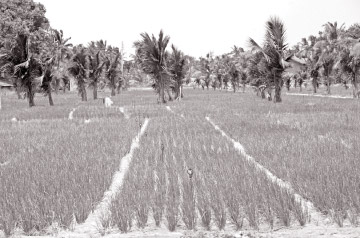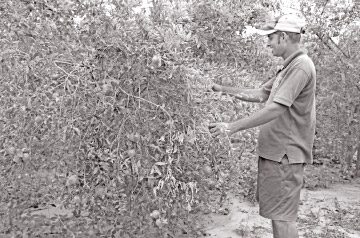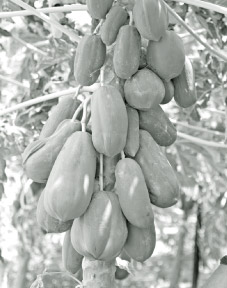Keep middlemen out, say Kalpitiya farmers
By Naalir Jamaldeen
Kalpitiya, a town 40 kilometres from Puttalam is well known for
agriculture. Fishery and agriculture are the main livelihood of the
people in the area. Palakkuda, a village in Kalpitiya is popular for
vegetables, papaya, guava, pomegranate and red onion cultivation. Grape
cultivation is carried out as a pilot project. The environment in
Kalpitiya is conducive for the cultivation of these crops.
 |
| A sketch of
red onion cultivation in Palakkuda |
 |
| A farmer tends
his pomegranate plants |
The farmers in Palakkuda have identified the technique to convert the
regasole soil into cultivable land, an Agricultural Instructor of
Kalpitiya division Asanka Sapumal said.
The Sunday Observer spoke to a cross section of farmers in Palakkuda
including Agricultural Instructors Sapumal and Gayathri Sashi Praba.
Sapumal said there are nearly 12, 000 hectares in the Kalpitiya
Division of which 5,000 to 6,000 hectares are used for cultivation. He
said the soil in the area is different from other areas. It is a
combination of sand and soil known as regasole soil. Cultivating crops
in such lands are not possible. The farmers use compost to make the
lands cultivable. Cow dung, gliricidia, goat dung and poultry dung are
used to improve the quality of the soil. Nearly 150 to 200 bags of
compost are laid to an acre. Three to five metric tons of compost will
be used by a farmer for a season depending on the extent of land he
cultivates.
Sapumal said Palakkuda is becoming popular for vegetable and fruit
cultivation.
He said farmers cultivate red onion on a large scale. A red onion,
variety Vethalam imported from India is used in the cultivation process.
If one kilo Vethalam variety red onion is cultivated 6 kilos of onion
can be harvested. Six hundred kilos of red onion is required for one
acre from which nearly 3,600 kilos of onion can be harvested .
|

Red lady variety papaya in Palakkuda |
Chillie takes second place among the crops cultivated in Palakkuda.
Hybrid variety chillie seeds are used for cultivation. Nearly 12,000
kilos can be harvested from one acre. Nearly two and a half kilos of
chillie can be plucked from each tree, according to Agricultural
Instructor Sapumal.
He said vegetables such as cabbage, cauliflower and beetroot are
cultivated in the Maha season.
Among the fruit cultivation papaya has a prominent place. Red lady
variety papaya seeds are used in the cultivation process, Sapumal said.
Pomegranate cultivation is also popular in Palakkuda. The Agriculture
Department has introduced three varieties of pomegranate, such as Nimali,
Daya and Nayana. Most of the farmers cultivate the Nimali variety .
Other varieties are also cultivated on a small scale.
Guava cultivation too is popular in Palakkuda, mainly the Bangkok
Giant Guava.Grape cultivation is gradually taking root in the region.
The Government has extended its cooperation to popularise grape
cultivation.
Sapumal said there is no shortage of water. Water is available round
the year. As the farmers depend on underground water, they do not
experience a shortage. Tube wells are used by the farmers. The maximum
depth of a tube well is 30 feet, he said.
The North Western Provincial Council allocated funds to improve crop
cultivation in the Kalpitiya area.
"Fertilizer is distributed through Agrarian Service Centres. We
provide advice and technical assistance to farmers. The Divi Neguma
program extends support to farmers" Sapumal said. H.M. Gayathri Sashi
Praba, an Agricultural instructor in the area said the compost and
chemical fertilizers should be applied equally to derive a benefit.
Compost is used in the initial stage to preserve the land. Compost is
costly and a fifty kilo pack is sold at Rs. 180. The farmers have to
bear the excess cost because they apply tons of compost to preserve the
land before commencing cultivation.
W. Amila Dhammika Tissera, a farmer said he cultivates papaya,
pomegranate and red onion in a three acre plot. He said the interference
of middlemen has affected the income of farmers and that the authorities
should purchase the products directly.
Francis Fernando said he has been engaged in agriculture for the past
40 years, and that there is a slight decrease in income because the
harvest has declined.
Farmer Amila Chandimal said he has been cultivating pomegranate for
nearly five years.He said cultivating pomegranate is a lucrative
enterprise mode but the trees should be maintained throughout the year
and nearly 5 to 6 months will take to pluck fruits. Nearly 400 kilos of
pomegranate can be plucked from 100 trees in the season.
The traders who purchase pomegranate from us pay Rs. 200, Chandimal
said. He said the Nimali variety has special features as it is sweet and
seedless. The Agriculture Department provides seeds and conducts
awareness programs from time to time.
M.H.D. Nimal said he has cultivated pomegranate in three acres and
earns enough income. If the products are purchased by the authorities
directly the income of farmers will increase several fold.
Unfortunately, the interference of middlemen have affected their income,
he said.
The Government should take steps to provide fertiliser on time.
Then the maximum benefit can be derived. Papaya cultivation is
another mode of income to the farmers in the area. The farmers work
tirelessly in their gardens but the income is grabbed by a third party,
he said.
S. Tilakawathi said she has cultivated papaya in one acre and gets a
good income from it.
The Divi Neguma accelerated Rural Development Program helps the
farmers in the area. If the trees are maintained by applying fertiliser
on time maximum harvest can be obtained.Tilakawathi said she earns more
than Rs. 5,000 during the season.
Generally, papaya yields a good crop throughout the year. However,
the month following warm temperature or moisture stress causes a skip in
production. Papaya is cultivated in Sri Lanka primarily as a home garden
crop. However, there is a limited extent under commercial scale and
though it is steadily increasing there is no significant increase in
production.
The reasons for it may be due to some districts being infected with
virus in the wet zone. Kurunegala is prominent for papaya production.
Kalutara, Ratnapura, Gampaha, Galle, Anuradapura, Puttalam, Hambantota
and Badulla districts also contribute to the national papaya production
according to Agriculture Department sources. |


